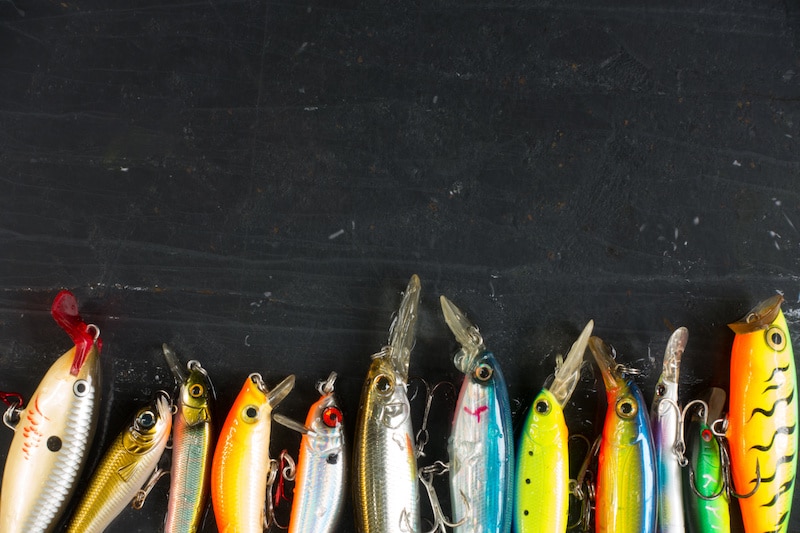What We'll Cover
You’re standing at the edge of the dock. You’ve got your fishing pole in hand, the tackle box is at your feet, and you’re ready to catch your first fish. There’s just one problem: you don’t know what fishing lure to use.
Many beginners have trouble figuring out which lures are the best for every situation. Yet when it comes to fishing, few choices are more important than your lure. After all, your lure is what ultimately attracts fish, and if they aren’t attracted, you won’t be having fish for dinner. That’s why we’ve put together this list of the best fishing lures for beginners. By understanding these lures, you’ll be off to a great start.
Crankbait
Crankbait fishing lures are one of the most common types of lures for good reason: they’re cheap, versatile, and effective. Sometimes called “plugs”, crankbaits are solid or hollow lures made to look like prey fish. Often, a plastic lip is attached to the front to make the crankbait wobble. Different plugs are designed for different depths, making crankbaits very versatile.
Rubber or Plastic Worms
There’s a reason that worms are a go-to choice when it comes to live bait. But if you don’t feel like fighting with a squirmy, live worm, you can use a plastic or rubber worm instead. You don’t have to worry about keeping your rubber lures alive, and they’re often easier to get on your hook. A rubber worm is a versatile lure that will attract a variety of fish. Rubber worms are so versatile that they’re even one of the most popular lures for ice fishing. Every newbie fisher should have at least a few rubber worms on hand.
Curl Tail Grub
Similar to rubber worms, a curl tail grub tries to emulate live bait. It features a distinct curl at the bottom that can be quite eye-catching—especially if you’re a fish. Every fisher, including beginners, should have a few curl tail grubs in their box. They are highly versatile and can used in a variety of water conditions to capture a wide range of fish.
Spoon
A spoon lure looks like, well, a spoon. A spoon lure usually has on oval shape and concave curve and is often crafted of metal. This helps accomplish two things. First, the lure features the general shape of a bait fish. Second, the concave curve and metal surface will create light reflections that help the lure catch the attention of fish and hopefully draw them in. Once in the water, you’ll have to retrieve the lure, helping it mimic the movement of prey fish.
Spinner Bait
Spinner bait uses metal blades to create propellers and also reflective materials to create light patterns. Once the bait is in the water, you’ll retrieve it, and while your reeling it in, the propellers will allow the bait to mimic live, moving fish. Spinner bait can be a bit trickier for beginners because they are not sit-and-wait baits. In clear water, you’ll want to retrieve quickly, but you can take it easier in murky water
Swim Bait
Most lures try to emulate bait fish in one way or other, and that might mean reflections or movements. Swim bait takes things a bit further. A swim bait lure will look like a real fish, complete with eyeballs, scales, and the like. Some even feature paddle tails that will thump in the water and look great on all different colors of fishing line. Good for capturing more aggressive predatory fish.
Topwater Frog
Many of the lures on here imitate fish, but you can also buy lures that imitate frogs. Some fish prefer to snatch their meal from the surface, making frog lures especially effective. These lures often feature tendrils at the end that will simulate legs. A fish at the bottom of a lake or river will see a swimming frog and might be tempted into a bite.
Lures are arguably one of the most important pieces of gear you should have in your tackle box, along with fishing pliers and a fillet knife. When you’re first starting out with fishing, you need to familiarize yourself with all your gear, and that includes lures. The lure is arguably the most important part of your fishing setup, so you need to know which ones are the best for every situation.
The responses below are not provided, commissioned, reviewed, approved, or otherwise endorsed by any financial entity or advertiser. It is not the advertiser’s responsibility to ensure all posts and/or questions are answered.



![Best Archery Sets This 2023 [Men & Women]](/assets/images/8cf78150f1d9d7a0c175609145d21517.png)

